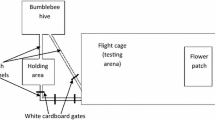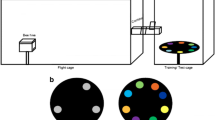Abstract
The performance of individual bumblebees at colour discrimination tasks was tested in a controlled laboratory environment. Bees were trained to discriminate between rewarded target colours and differently coloured distractors, and then tested in non-rewarded foraging bouts. For the discrimination of large colour distances bees made relatively fast decisions and selected target colours with a high degree of accuracy, but for the discrimination of smaller colour distances the accuracy decreased and the bees response times to find correct flowers significantly increased. For small colour distances there was also significant linear correlations between accuracy and response time for the individual bees. The results show both between task and within task speed-accuracy tradeoffs in bees, which suggests the possibility of a sophisticated and dynamic decision-making process.




Similar content being viewed by others
References
Chittka L (1992) The colour hexagon: a chromaticity diagram based on photoreceptor excitations as a generalized representation of colour opponency. J Comp Physiol A 170:533–543
Chittka L, Gumbert A, Kunze J (1997) Foraging dynamics of bumble bees: correlates of movements within and between plant species. Behav Ecol 8: 239–249
Chittka L, Dyer AG, Bock F, Dornhaus A (2003) Bees trade off foraging speed for accuracy. Nature 424:388
Dyer AG, Chittka L (2004a) Biological significance of distinguishing between similar colours in spectrally variable illumination: bumblebees (Bombus terrestris) as a case study. J Comp Physiol A 190:105–114
Dyer AG, Chittka L (2004b) Fine colour discrimination requires differential conditioning in bumblebees. Naturwissenschaften 91:224–227
Franks NR, Dornhaus A, Fitzsimmons JP, Stevens M (2003) Speed versus accuracy in collective decision making. Proc R Soc Lond B Biol Sci 270:2457–2463
Giurfa M (2004) Conditioning procedure and color discrimination in the honeybee Apis mellifera. Naturwissenschaften 91:228–231
Giurfa M, Núnez J, Chittka L, Menzel R (1995) Colour preferences of flower-naive honeybees. J Comp Physiol A 177:247–259
Menzel R, Backhaus W (1991) Colour vision in insects. In: Gouras P (ed) Vision and visual dysfunction, vol 6, The perception of colour. Macmillan Press, London, pp 262–293
Pachella RG (1974) The interpretation of reaction time in information-processing research. In: Kantowitz B (ed) Human information processing: tutotial in performance and recognition. Erlbaum, Hillsdale, NJ, pp 41–82
Pachella RG, Fisher DF (1969) Effect of stimulus degradation and similarity on the tradeoff between speed and accuracy in absolute judgements. J Exp Psychol 81:7–9
Peitsch D, Fietz A, Hertel H, de Souza J, Ventura DF, Menzel R (1992) The spectral input systems of hymenopteran insects and their receptor-based colour vision. J Comp Physiol A 170:23–40
Plamondon R, Alimi AM (1997) Speed/accuracy tradeoffs in target-directed movements. Behav Brain Sci 20:279–349
Rival C, Olivier I, Ceyte H (2003) Effects of temporal and/or spatial instructions on the speed-accuracy tradeoff of pointing movements in children. Neurosci Lett 336:65–69
Zenger B, Fahle M (1997) Missed targets are more frequent than false alarms: a model for error rates in visual search. J Exp Psychol 23:1783–1791
Acknowledgements
We thank Professor W.R.A. Muntz, Dr. L.L. Muir and two anonymous referees for their comments on the manuscript. A.G. Dyer is grateful for support from the Alexander von Humboldt Foundation.
Author information
Authors and Affiliations
Corresponding author
Rights and permissions
About this article
Cite this article
Dyer, A.G., Chittka, L. Bumblebees (Bombus terrestris) sacrifice foraging speed to solve difficult colour discrimination tasks. J Comp Physiol A 190, 759–763 (2004). https://doi.org/10.1007/s00359-004-0547-y
Received:
Revised:
Accepted:
Published:
Issue Date:
DOI: https://doi.org/10.1007/s00359-004-0547-y




